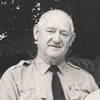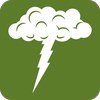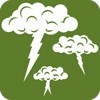
Lightning is dangerous!
We are sad about these tragedies, but there is some good news. Only three people have been killed by lightning at Bryce Canyon in approximately 20 years -- even though our national park has the highest lightning hazard density in the state of Utah. As you can see, most of our visitors have a safe and memorable trip to Bryce Canyon. Read below about lightning, and then take the Don't Get Zapped quiz. After taking the quiz, you can print yourself a Certificate! 
NPS Photo A National Park Service Ranger has a record for being zapped/struck the most by lightning. Ranger Roy "Dooms" Sullivan was struck by lightning a total of 7 times over 40 years...and lived through every single strike! However, these are what lightning did to him:
Lightning is Electricity; Thunder is a Sound Wave Lightning is electricity, just like the kind that comes out of a home wall socket into a lamp or TV. Lightning is caused by tiny, subatomic particles that have a + or - charge. When they move from one cloud to another, or from a cloud to the ground...well, that's lightning! As a lightning bolt travels in a micro-second through the air, it pushes apart the air. This "push" travels as a sound wave which is slower than the flash of lightning. That's why you see the lightning first, and then hear the thunder. When Thunder Roars, Go Indoors!
When thunder roars, go indoors! You are not safe anywhere outside. Run to a safe building or vehicle when you first hear thunder, see lightning or observe dark threatening clouds developing overhead. Stay inside until 30 minutes after you hear the last clap of thunder. Do not shelter under trees. The building could be the Visitor Center, Bryce Canyon Lodge, or even the bathroom at Sunset Point (which has electricity and plumbing). A bus shelter with open sides will protect you from rain, but not from lightning! You can use the time waiting for the storm to pass working on your Junior Ranger book!
When Does Bryce Canyon Get Lightning? The chart below shows which month is likely to have the most precipitation (as rain) and lightning.

|
Last updated: April 23, 2024



